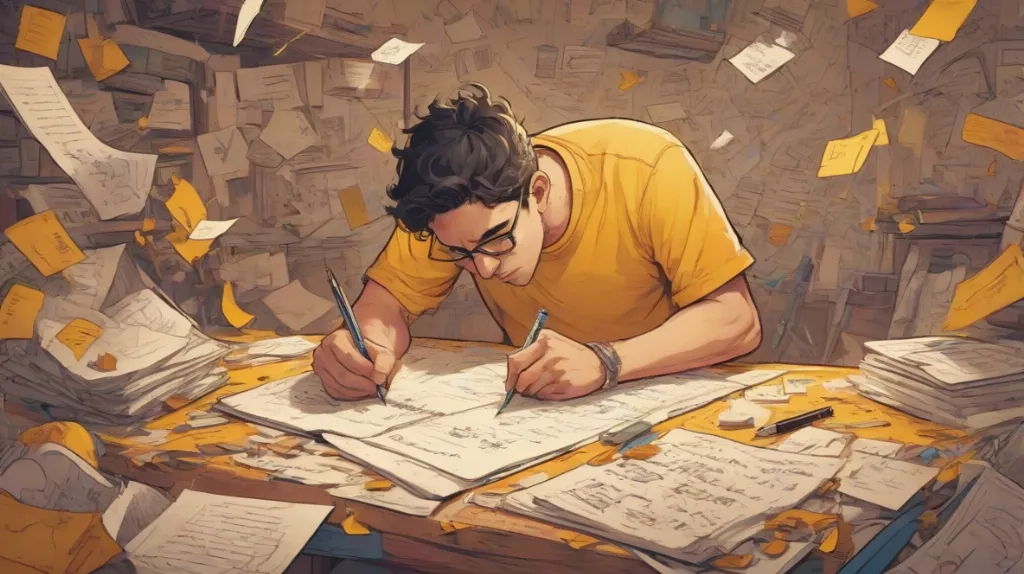What Does It Mean to Dream of Dysgraphic ?
Posted on: November 2, 2024
Last updated: February 19, 2025
Dysgraphia in dreams symbolizes struggles with communication and self-expression, reflecting feelings of inadequacy. It indicates a disconnect between thoughts and actions, urging the dreamer to reassess priorities. This symbol emphasizes the need for patience and understanding while navigating communication barriers, encouraging support from others to overcome challenges.

What does Dysgraphic mean in a dream?
The symbol of dysgraphia in dreams often reflects deeper issues related to communication and expression. Individuals experiencing such dreams may find themselves grappling with feelings of inadequacy or frustration when it comes to articulating their thoughts. This symbol can indicate a struggle with self-expression, suggesting that the dreamer might be facing challenges in conveying their ideas effectively in waking life. It is essential to explore these feelings, as they can reveal underlying insecurities that need to be addressed.
Additionally, dysgraphia in the context of a dream book can symbolize a disconnect between the mind and body. The dreamer may feel overwhelmed by the demands of daily life, leading to a sense of chaos in their thoughts. This symbol serves as a reminder to take a step back and reassess one’s priorities. The dream may encourage the individual to find alternative methods of expression that align more closely with their true self.
Moreover, dreams featuring dysgraphia can also highlight the importance of patience and understanding, both for oneself and others. The journey to overcome communication barriers is often fraught with obstacles, and this symbol can represent the need for compassion in the face of such challenges. It may be beneficial to seek support from friends or professionals who can offer guidance and encouragement during this process.
In summary, the presence of dysgraphia in dreams is a multifaceted symbol that encompasses themes of communication, self-discovery, and emotional resilience. It invites the dreamer to explore their feelings and consider how they can improve their ability to express themselves. By embracing this journey, individuals may uncover new pathways to connect with others and share their unique perspectives.
Meaning in dream books
Psychoanalytical Interpretations
Repressed Emotions: In psychoanalysis, dysgraphic symbols in dreams can indicate repressed emotions. This suggests that the dreamer may be struggling to express their feelings, leading to anxiety or frustration in their waking life.
Fear of Judgment: The presence of dysgraphic elements may reflect a fear of being judged or misunderstood. This interpretation points to the dreamer’s concerns about how others perceive their thoughts and expressions.
Self-Identity Issues: Dysgraphia in dreams can also highlight issues related to self-identity. It may indicate that the dreamer is questioning their sense of self and how they communicate their identity to the world.
Symbolism in Esotericism
Communication Barriers: The appearance of dysgraphic elements in dreams may symbolize difficulties in expressing oneself. This can indicate a struggle to convey thoughts and emotions in waking life, reflecting a deeper spiritual or emotional blockage.
Inner Conflict: Dysgraphia in dreams can represent an internal conflict between one’s desires and the ability to articulate them. This may suggest the need for self-reflection and understanding of one’s true feelings.
Transformation and Growth: Encountering dysgraphic symbols might signify a period of transformation. It could imply that the dreamer is on a journey toward personal growth, where overcoming communication challenges is essential for spiritual evolution.
Dysgraphic in different cultural contexts in dreams
In the realm of dream interpretation, the symbol of dysgraphic holds a unique place, reflecting the intricate tapestry of cultural beliefs and values. In Western culture, dreams often serve as a mirror to our subconscious, revealing our hidden fears and desires. The dysgraphic symbol may resonate with individuals who struggle with self-expression, highlighting a disconnect between their inner thoughts and the ability to articulate them. This struggle can be seen as a metaphor for broader societal challenges, where the pressure to conform and communicate effectively can lead to feelings of inadequacy and frustration.
Turning to Slavic culture, the interpretation of dreams takes on a more mystical quality, often intertwined with folklore and ancestral wisdom. In this context, the dysgraphic symbol may signify a warning or a call to reconnect with one’s roots. It suggests that the dreamer may be grappling with their identity or heritage, feeling lost in a world that demands clarity and precision. The dysgraphic experience in dreams can thus be viewed as an invitation to explore one’s cultural lineage and embrace the complexities of personal history.
In Eastern cultures, where spirituality and introspection are highly valued, the dysgraphic symbol may represent a journey towards enlightenment. Here, the struggle with expression can be seen as a necessary step in the path of self-discovery. Dreams featuring dysgraphic elements may encourage individuals to look beyond the surface, urging them to delve deeper into their emotional and spiritual selves. This perspective emphasizes the importance of patience and understanding in the face of communication barriers.
Lastly, in Oriental traditions, dreams are often viewed as messages from the universe or the divine. The dysgraphic symbol could be interpreted as a sign of imbalance, indicating that the dreamer may need to realign their thoughts and actions. It serves as a reminder that true expression comes from within and that overcoming the challenges associated with dysgraphic experiences can lead to profound personal growth. Overall, the cultural context of this symbol enriches its meaning, offering a multifaceted lens through which to understand the complexities of communication and self-expression.
Dysgraphic in other contexts of use
Dysgraphic
The term ‘dysgraphic’ in dreams often symbolizes challenges in communication and expression. It may reflect feelings of inadequacy or frustration in conveying thoughts and emotions. Here are various contexts in which ‘dysgraphic’ may appear in dreams:
Struggling to write
Experiencing difficulty in writing can indicate a fear of not being understood or a lack of confidence in one’s abilities.
Messy handwriting
Seeing messy handwriting may symbolize chaotic thoughts or emotions that are hard to articulate.
Writing with a broken pencil
A broken pencil can represent obstacles in expressing oneself or feeling hindered in communication.
Receiving poor grades on writing assignments
This scenario can reflect self-doubt and the fear of judgment from others regarding one’s abilities.
Being unable to finish a sentence
Inability to complete thoughts may indicate anxiety about expressing oneself clearly in waking life.
Writing in a foreign language
This can symbolize feelings of alienation or the struggle to connect with others.
Seeing others write effortlessly
Witnessing others write with ease may evoke feelings of envy or inadequacy regarding one’s own skills.
Writing in a dream journal
This may signify a desire to process emotions or thoughts that are difficult to articulate.
Using a typewriter
A typewriter can symbolize a longing for simpler forms of communication or nostalgia for the past.
Writing a letter
Writing a letter in a dream may indicate a need to communicate feelings or thoughts that have been suppressed.
Receiving a letter with poor handwriting
This could symbolize receiving mixed messages or unclear communication from others.
Writing on a chalkboard
This may represent a desire to teach or share knowledge but feeling restricted in doing so.
Drawing instead of writing
Choosing to draw instead of write can indicate a preference for visual expression over verbal communication.
Feeling embarrassed about writing
Embarrassment in a writing scenario may reflect anxiety about being judged or misunderstood.
Writing in the dark
This can symbolize confusion or uncertainty in expressing oneself.
Writing with colorful pens
Using vibrant colors may indicate a desire to express oneself more creatively, despite feeling dysgraphic.
Being critiqued for writing
Receiving criticism can symbolize fear of failure or rejection in communication.
Writing a poem
Attempting to write poetry may reflect a deep emotional need to express feelings that are difficult to articulate.
Writing in a diary
This scenario can symbolize introspection and the need to explore one’s inner thoughts and feelings.
Writing a speech
Preparing a speech in a dream may indicate anxiety about public speaking or sharing one’s ideas with others.
Using technology to write
Utilizing modern technology to write may represent a desire for more efficient communication methods.
Writing in a crowded place
This may symbolize feeling overwhelmed by distractions while trying to express oneself.
Writing with someone watching
Feeling observed while writing can evoke anxiety about being judged or misinterpreted.
Writing a novel
Dreaming of writing a novel may reflect aspirations or ambitions that feel out of reach due to communication barriers.
Writing on a wall
This can symbolize a desire to leave a mark or message but feeling restricted in doing so.
Writing in a dream class
Participating in a class focused on writing may indicate a desire for personal growth and improvement in communication skills.
Writing a script for a play
This may symbolize a need to express one’s life story or experiences in a creative format.
Writing with a quill
Using a quill can symbolize a longing for authenticity and traditional forms of expression.
Being praised for writing
Receiving compliments for writing may indicate a desire for validation and recognition of one’s abilities.
Writing in a foreign script
This can symbolize feelings of confusion or alienation in communication.
Writing a blog
Dreaming of blogging may reflect a desire to share thoughts and experiences with a broader audience.
Writing a song
This may symbolize a deep emotional need to express feelings through music and lyrics.
Writing with a heavy heart
Feeling burdened while writing can indicate emotional struggles that are hard to articulate.
Writing in a public space
This scenario may symbolize vulnerability in sharing personal thoughts with others.
Writing a manifesto
Dreaming of writing a manifesto may reflect strong beliefs and a desire to communicate them effectively.
Writing a love letter
This can symbolize deep feelings of affection that are difficult to express verbally.
Writing a resignation letter
Dreaming of resigning from a job in writing may indicate a desire for change or a need to express dissatisfaction.


Comments posted under the entry: 0
The user must be logged in to comment or view comments.